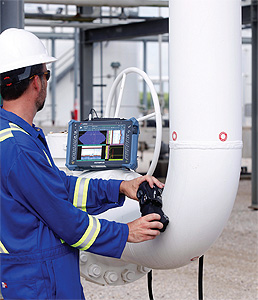Olympus: Innovating Scientific Solutions Across Industries to Exceed Expectations
The power of flexibility
Olympus has built its name and recognition on the back of offering scientific solutions based on innovative products and services that anticipate the evolving needs, and exceed the expectations of professionals from various different industry segments. Its industrial solutions range from materials science microscopes and industrial videoscopes, to non-destructive testing technology and x-ray analysers. These are widely used for quality control, inspection and measurement applications, and help to contribute to product quality, and the safety of infrastructure and facilities in a number of fields.
In the oil and gas industry, for example, where safety is the priority and unplanned downtime is costly, a robust nondestructive testing programme is important to help maintain the safety of people and the environment, and to keep pipelines operating efficiently. To meet these requirements, inspectors typically use x-ray fluorescence analysers to verify that pipelines are made from the proper alloy, and ultrasonic and phased array flaw detectors to check pipelines and welds for flaws and corrosion.
In October 2018, Olympus introduced a new phased array ultrasonic testing (PAUT) solution for the reliable inspection of pipe elbows – the FlexoFORM™ scanner. Incorporating Olympus’ proven flexible array probe technology with an innovative water wedge designed to conform to the inner and outer curved surfaces of pipe elbows, the FlexoFORM™ scanner can acquire corrosion mapping data for a complete picture of a pipe elbow’s integrity.
Thanks to a number of advanced features, this scanner solution offers several advantages:
100 per cent pipe elbow coverage: FlexoFORM™ water wedges feature a foam gasket that contours to the elbow’s inner and outer curves, helping ensure a reliable signal of the entire circumference of pipes 4.5 in. OD and up.
Reduces preparation time: An encoder maps the scan axis of the pipe, and an indexing button is located right on the scanner to increment the index axis. Drawing lines is optional, depending on the level of precision required.
Acquires high-resolution data (1 mm × 1 mm): Olympus’ advanced imaging technology provides a comprehensive image of the overall condition of the pipe elbow and facilitates the analysis of flaws, such as corrosion pitting and mid-wall lamination, inclusions, and remaining wall thickness.
Smoother and faster scanning: Minimal operator effort is required. Magnetic wheels are positioned to support the FlexoFORM™ scanner so that it naturally follows the centerline of the pipe elbow.
Cost effective and versatile: The same scanner and phased array probe are used to cover the entire range of diameters. Only the water wedge needs to be changed to adapt to a different diameter.
The FlexoFORM™ scanner is used with an OmniScan® MX2 or SX flaw detector to acquire and save data in order to detect and measure different types of damage or anomalies. The high-density data combined with the multiple views available directly in the flaw detector or through OmniPC™ software provide clear images of the pipe material’s condition and make data interpretation faster and easier. As the entire surface of the elbow is covered, the FlexoFORM™ solution is less dependent on the operator and provides an improved probability of detection as compared to simple spot checking. The scan direction is encoded, and an indexing button is positioned directly on the scanner to perform the index increment in the second axis to create 2D surface maps within the same file.
The FlexoFORM™ scanner can also inspect pipes in the longitudinal direction. This configuration is especially useful for smaller pipes or when the region of interest is concentrated within a specific sector around the pipe. In these situations, inspection in the longitudinal axis can be more appropriate than scanning in the circumferential direction with a flat phased array probe. The FlexoFORM scanner can also be a powerful tool for the inspection of water walls in power generation boilers.
For further information please visit: www.olympus.co.uk